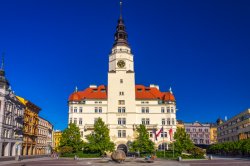Opava
In the fertile valley on the river Opava lies the statutory town of the same name, territorially falling under the Moravian-Silesian Region and between 1742 and 1928 holding the status of the capital in Bohemian Silesia.
Information for visitors
Interesting facts Opava
History of the town
The local area has been inhabited since prehistoric times. In the Middle Ages, Opava occupied a strategic position at the crossroads of trade routes and the Amber Trail, which connected the Baltic with the Adriatic. The first historical mention of Opava dates back to 1195.
The original settlement was concentrated around Horní and Dolní náměstí and Mezi Trhy Street. At the end of the 13th century, a mint was established in Opava, and at the beginning of the 14th century, the Principality of Opava was established, later the duchy. After the Battle of White Mountain, the Jesuits were invited to the town, and in 1630 a Jesuit grammar school was established there. After the division of Silesia between the Habsburg monarchy and Prussia, Opava became the administrative center of Austrian Silesia, later Czechoslovak Silesia, until 1928.
In 1820, a congress of the Holy Alliance was held in Opava - the Austrian Emperor Francis I, the Russian Tsar Alexander I, the Prussian King Bedřich Vilém III. and representatives of France and England. During the 19th century, textile businesses and sugar factories also began to appear here, and in 1855 the Northern Railway of Ferdinand was opened.
Nationally, Opava was largely German, which did not change until the second half of the 19th century, when the Czech grammar school and Matice opavská were founded. The Opava Besedník and later the weekly began to be published. After the First World War, Opava was the capital of the province of Sudetenland.
During World War II, Opava became the center of a Sudetenland, about a third of the city was destroyed and a large number of inhabitants lost their lives. In the post-war period, industrial plants and new residential areas were built.
Monuments and interesting places
Among the oldest historical monuments of Opava is the church of St. Ducha and the Minorite monastery from the 13th century. From the second half of the 14th century is the co-cathedral1) of the Assumption of the Virgin Mary. A pleasant walk through the city promises Masarykova třída, Ostrožná street or Dolní náměstí with a number of Renaissance houses.
Architectural examples of the Baroque style in Opava are Blűcherův palác or Sobkův palác, then the Church of St. Vojtěch, the Jesuit College and the Marian Column. Among the modern architecture, let us mention the Breda department store or the Municipal Swimming Pool complex.
1) Concathedral - the main church of the diocese
Author: Andrea Štyndlová

